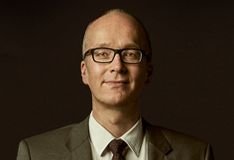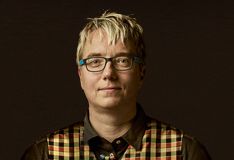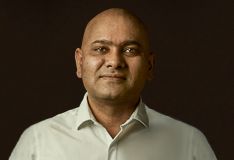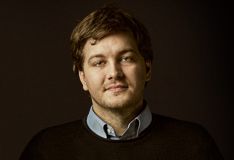Recognising the UK’s strong research capabilities in Quantum Technologies, the UK Government has so far invested around £400 million in the UK National Quantum Technologies Programme, a collaborative initiative to advance technology and provide long-term benefits to society. Four quantum technology hubs were created within the programme, each with a particular focus. Of this funding, the UK Quantum Technology Hub Sensors and Timing with its partner universities has to date received projects valued at £165 million.
Dr Simon Bennett (Director) and
Professor Kai Bongs (Principle Investigator) and their teams at the
UK Quantum Technology Hub Sensors and Timing are working with partners across industry and academia, encompassing different disciplines including Electrical Engineering, Civil Engineering and Psychology, to translate laboratory science in to real-world situations to solve the challenges facing society and the environment today.

Birmingham Heroes: Professor Kai Bongs talks Quantum Technologies
Birmingham Heroes: Dr Nicole Metje talks quantum technology
The UK Quantum Technology Hub Sensors and Timing
The UK Quantum Technology Hub Sensors and Timing, led by the University of Birmingham, has had a major impact on the economy and commerce.
Part of the UK National Quantum Technologies Programme set up in 2014, the UK Quantum Technology Hub Sensors and Timing was allocated 28% of the £214m funding from the Engineering and Physical Sciences Research Council to develop quantum technology (QT) to measure time and gravity with extreme precision. This has led to a strategic shift in public spending priorities by the Ministry of Defence and the Defence Science and Technology Laboratory (Dstl) – resulting in the investment of over £11.5 million of public funding into gravity and timing QT.
The Hub has also enabled an ecosystem of over 70 companies to engage in QT research. This reach extends to numerous multi-national companies, informing their commercial strategic decisions, investment priorities and product pipeline. The Hub leads over 110 projects, valued at approximately £120 million, and has 17 patent applications.
Ultra-Precise Sensors
Gravity sensors, making the invisible visible, improving health and safety and reducing risks during excavation.
The team, comprising physicists and civil engineers, is developing gravity sensors to detect buried infrastructure, enabling a new and better way of seeing underground and spotting hazards before they arise, for example, identifying sinkholes before they open. The sensors will also allow for more targeted and effective maintenance of our roads, thereby reducing congestion and traffic jams.
The sensors, which have been developed by Professor Kai Bongs, Dr Michael Holynski and their team within the School of Physics and Astronomy, will use cold-atom technology to provide a much more precise and faster measurement of gravity. By using atoms as probe particles, the gravity sensors can sense a person just by their gravitational field. Since gravity penetrates any material, these devices facilitate ‘seeing’ into the ground. They will, in particular, be sensitive to density variations.
Enabling these sensors to deliver real-world benefits is an interdisciplinary effort. The team from Physics is working closely with Dr Nicole Metje and her team within the Department of Civil Engineering to link to end-users and identify key applications and requirements.
This technology will allow us to map what lies beneath our feet and detect a variety of hidden infrastructure including mineshafts, sinkholes, pipes and tunnels.
This will ultimately revolutionise how construction takes place - we are currently unable to pinpoint sources of problems such as the bursting of underground pipes, which is why roadworks can be so extensive and disruptive. By showing the exact location of problems underground, the Hub’s research will reduce disruption on the nation’s roads.
Quantum technology gravity sensors are an exciting innovation which will allow us to use our underground space much more safely and will offer us new ways to use that space in future, including building into the ground rather than above it.
Clocks
Timekeeping is essential for modern life. Much of our everyday technology is underpinned by precision timing, including satellite navigation, high-speed financial trade and broadband communication. Professor Kai Bongs, Dr Yeshpal Singh and the team have been conducting research to develop ultra-precise optical clocks.
To enable new applications and improve existing technologies, more accurate and precise timing is required. At the Hub, we are developing compact, portable and robust “optical clocks” which will have a thousand to ten thousand times higher precision than the ones currently available.
The practical applications of precise clocks are widespread and varied: examples include boosting the future of the communications network, including deep-space satellite navigation and communications, and driving the next generation of broadband for a super high-speed internet.
Quantum clocks are making time more accurate; the sensors used in them are not just sensitive but very quick. For example, the clocks built as a result of this technology will be found in fast-paced, high-frequency trading in financial markets, where the measurement of time to determine who bids first needs to be accurate.

Professor Kai Bongs
“Quantum technology has the potential to transform the world in ways we can barely imagine.”
Health benefits
The revolutionary technology coming out of the Quantum Technology Hub will also have medicinal and health applications.
Atomic magnetic sensors are precise enough to pick up tiny magnetic fields associated with brain activity or cell communications. Research could produce technologies which are steered by thought, revolutionising computer games and dangerous work environments as well as healthcare.
One such improvement will bring about a non-invasive way of measuring brain activity to further research into dementia, which is often related to obstructed communication channels in the brain. Magnetic sensors could soon be used to look deep into the brain. The Hub has theorised that a sensitive magnetic helmet could pick up cerebral communications and identify problems, allowing doctors to provide earlier diagnoses for dementia, assess the efficacy of drugs, and even help to prevent the onset of symptoms in those who have been diagnosed in order to ensure a longer and more fulfilling life.
Birmingham Heroes: Dr Michael Holynski talks quantum technologies
Birmingham Heroes: Dr Yeshpal Singh talks quantum
Quantum Technology is based upon the science of the very small. It utilises an understanding of the physics of atomic particles, to harness the ‘spooky’ side of quantum mechanics. It has been discovered that a particle can be in two places at the same time, moving in two directions. If we let a particle simultaneously explore two paths at different heights, it can be used to measure gravity and acceleration. If the paths enclose an area, it will sense rotation and if they differ internally, it will measure time or magnetic fields with the utmost precision.
The quantum sensors developed in the Hub exploit the nature and internal structure of atoms and ions as quantum probes. The Hub works closely with industry partners, such as BP, Samsung and Network Rail, to provide a space for innovation and translate the Hub’s world-leading research in quantum sensors into real-world solutions.

Professor of Cold Atom Physics

Reader in Infrastructure Monitoring

School of Physics and Astronomy

Innovation Fellow
This Matters - Gravity Sensors
This Matters - Quantum Clocks
Find out more
Ψ in the sky ➤
How can Quantum Technology make the underground visible? ➤
Gravity at Birmingham ➤
National Buried Infrastructure Facility (NBIF) ➤
SIGMA + ➤
the UK Quantum Technology Hub Sensors and Timing - Annual Reports ➤
University of Birmingham heads £80m quantum technology hub ➤
Learn about our other Birmingham Heroes ➤